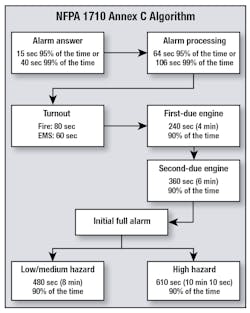NFPA 1710: Standard for the Organization and Deployment of Fire Suppression Operations, Emergency Medical Operations, and Special Operations to the Public by Career Fire Departments recently turned 20 years old.
In the late 1990s, there was a lot of animosity concerning the proposal that the NFPA create a deployment standard for career fire departments. The first edition of the standard was the most controversial standard that ever was published by the organization. Fire chiefs weren’t quite sure what to expect from it, and city and county managers were outraged that a standard would “dictate” how many firefighters should be on an apparatus. Nevertheless, the approval for the standard was passed by the NFPA membership, and in 2001, the first edition was published.
The first edition of the standard established:
- minimum on-duty staffing requirements for engine and ladder/truck companies;
- objectives (what now are called Performance Objectives) for fire and EMS;
- the minimum number of firefighters that are required on the initial full-alarm assignment to a single-family dwelling; and
- reporting requirements to authorities having jurisdiction (AHJs).
The standard has a five-year revision cycle. (All NFPA standards have revision cycles.) The 2020 edition was the fifth revision and became effective on May 18, 2019. It supersedes all previous editions.
Each edition clarified and added new language as new topics were addressed. The first edition addressed fires in single-family dwellings and the tasks that typically were required at such occupancies. Three more occupancies now are addressed (open-air strip shopping centers, garden-style apartments and high-rise buildings), as are the tasks that are required to be undertaken by the effective response force.
Over the past 20 years, the controversy on the standard died down on the national level. On the local level, NFPA 1710 is the subject of many arbitrations and proceedings.The major changes
As with most revisions, the 2020 edition cleaned up and clarified numerous areas. Also, the NFPA staff added something new: There now are shaded portions and symbols to indicate deletions, revisions and new materials. This makes it a lot easier to scan the document for changes.
As well, the 1710 committee added a people count. The count reflects the number of people who are required next to each task that’s listed. It also indicates the final sum for the initial full-alarm assignment for the various types of occupancies that are covered. Easy-to-read tables and algorithms were added to the annex materials, which make it less complicated to find the various requirements within the standard.
Here is a list of the most significant changes. Where applicable, my comments follow each change.
3.3.13 Career Fire Department—A fire department that utilizes full-time or full-time-equivalent (FTE) station-based personnel immediately available to comprise at least 50 percent of an initial full-alarm assignment.
This modifies the previous definition, which stated that the standard was for services provided “by substantially all career departments.”
3.3.28 First-Due Response Zone—The geographic area surrounding a fire station in which a company from that station is projected to be the first to arrive on the scene of an incident.
This is new language; previously, the standard didn’t address the issue by territory, only by travel time to incidents.
3.3.32 Geographical Isolation—A first-due response zone or jurisdiction with staffed resources where over 80 percent of the response area is outside of a 10-minute travel time from the next closest staffed suppression apparatus.
This is a new definition that’s related to new language in 5.2.3.1.2/5.2.3.2.2.
3.3.33 Geographical Restriction—A defined condition, measure, or infrastructure design that limits response and/or results in predictable response delays to certain portions of the jurisdiction.
This also represents a new definition that’s related to new language in 5.2.3.1.2/5.2.3.2.2.
Infrastructure design includes a railroad crossing, a drawbridge and a narrow street.
3.3.53 Rapid Intervention Crew (RIC)—A dedicated crew of firefighters, at least one officer and three members, positioned outside the IDLH, trained and equipped as specified in NFPA 1407: Standard for Training Fire Service Rapid Intervention Crews, who are assigned for rapid deployment to rescue lost or trapped members.
The text in italics is newly added language.
3.3.53.1 Initial Rapid Intervention Crew (IRIC)—Two members of the initial attack crew, positioned outside the IDLH, trained and equipped as specified in NFPA 1407, who are assigned for rapid deployment (i.e., two in/two out) to rescue lost or trapped members, trained and equipped as specified in NFPA 1407.
The text in italics is newly added language.
4.1.2.1 (4) 360 seconds or less travel time for the arrival of the second company with a minimum staffing of 4 personnel at a fire suppression incident.
Subsection (4) was added just after the existing section 4.1.2.1 (3), which requires 240 seconds or less travel time for the arrival of the first engine company at a fire suppression incident. The previous edition didn’t require the second-arriving unit to arrive any sooner than other responding units: 480 seconds for apartments and strip shopping centers, and 610 seconds for high-rise buildings.
5.2.1.2 Response personnel shall be trained in their assigned positions in accordance with Sections 5.2 and 5.3 of NFPA 1500: Standard on Fire Department Occupational Safety, Health, and Wellness Program.
New language was added to incorporate required training by NFPA 1500. 5.2 is member qualifications, and 5.3 is training.
5.2.2.3 An incident safety officer shall be deployed upon confirmation of a structural fire, at a special operations incident or when significant risk is present to the member due to the nature of an incident.
Previously, safety officers only were required to be deployed to incidents that escalated beyond a full-alarm assignment or when members faced a significant risk.
5.2.2.3.1 The incident safety officer, meeting the requirements as specified for the incident safety officer in NFPA 1521: Standard for Fire Department Safety Officer Professional Qualifications, shall have the expertise to evaluate hazards and provide direction with respect to the overall safety of personnel.
This adds some requirements to the safety officer position.
5.2.3.1.2/5.2.3.2.2 In jurisdictions first-due response zones with a high number of incidents or, geographical restrictions, geographical isolation, or urban areas, as identified by the AHJ, these companies shall be staffed with a minimum of five on-duty members.
This relates to new definitions that are noted in the aforementioned and addresses areas that present special circumstances to jurisdictions.
5.2.3.1.2.1/5.2.3.2.2.1 In jurisdictions first-due response zones with tactical hazards, high-hazard occupancies, or dense urban areas, as identified by the AHJ, these fire companies shall be staffed with a minimum of six on-duty members.
This relates to new definitions that are noted above and addresses areas that present special circumstances to jurisdictions.
5.2.3.5.2 This tanker/tender shall be staffed with a minimum of two on-duty members [tankers and tenders being defined in Chapter 3: Definitions].
5.2.3.6 Emergency Medical Care—Where emergency medical care is provided by outside agencies or organizations, those personnel shall be included in the deployment plan and meet the requirements as stated.
Jurisdiction can’t ignore the standard’s requirements by hiring private providers.
Also, 5.2.4.1.1 is a modification that adds the two firefighters to the total effective response force for the RIC. The previous edition included two for the IRIC. The committee believes that the full RIC needed to be included in the total effective response force. This increases the total from 14/15 to 16/17 for a single-family dwelling.
Benchmark
NFPA 1710 is recognized as a national standard. Departments across North America measure themselves by the performance objectives that are established within it. I believe that many of the changes that are in the new edition of the standard are significant and do what the founders envisioned.
I am very proud to have worked on the committee for 15 years and with committee members who had our service at the forefront.
NFPA 1710 can be read for free (or purchased) online at NFPA.org/1710.
About the Author
William Bryson
William “Shorty” Bryson has been in the fire service since 1975. He was the fire chief for the City of Miami, FL, Department of Fire-Rescue and Miami-Dade, FL, Fire Rescue. His awards include the Fire Chief of the Year (2008) and the Lifetime Achievement Award (2016). He is a strong proponent of cooperative labor management relations and was a member and chair on the NFPA 1710 committee from 2005 to 2019.

